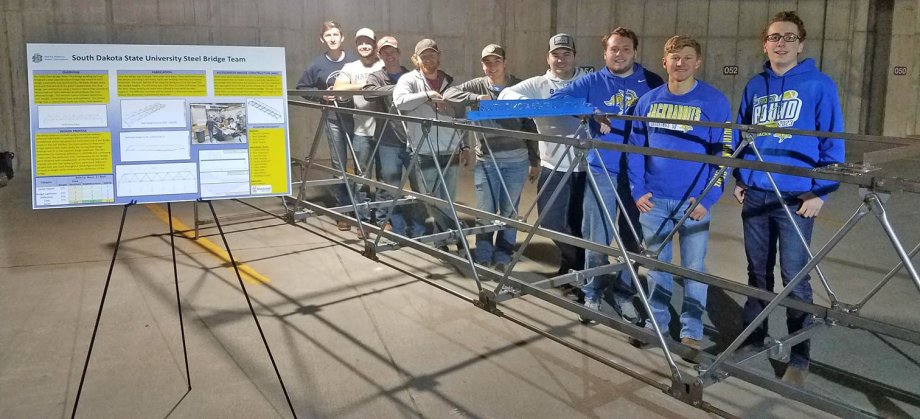
Team members are, from front to back, are Matthew Croke, Luke Nichols, Alex Foley, Jalen DeJong, Jack Roering, Riley Oetken, Josiah Anderson, Caleb Huizenga and Erik Thompson.
Tackling a complicated bridge-building project with an inexperienced crew, a group of civil engineering students from South Dakota State University figured out how to span the Sweetwater River near San Diego and qualified for a national competition.
The American Society of Civil Engineers began the student steel bridge competition in 1987, challenging student teams to develop a scale-model steel bridge to fit a given hypothetical environment. Each team must determine how to design and fabricate a bridge and then plan for an efficient assembly under timed construction at a competition. Bridges are then load-tested and weighed.
SDSU students competed in the Mid-America Student Symposium at Kansas State University in Manhattan April 15, finishing third and qualifying for nationals in San Diego June 2-3.
This is the first time since 2019 and only the second time in school history for the bridge-building team to qualify for nationals.
“The fact that we’ve only qualified twice for nationals speaks to the challenge of the event, and this year’s design competition was particularly challenging because of the bridge span length increasing by three feet from the 2022 competition. The longer bridge span will cause more vertical deflection so the bridge will have to be stiffer; and a longer bridge will have an increased self-weight and it will take longer to build,” said Zachary Gutzmer, adviser for SDSU's ASCE student chapter and lecturer in the Department of Civil and Environmental Engineering.
Preparation pays off
What the team of 12 civil engineering students came up with after designing three different styles of bridges and doing 3D modeling was a superstructure bridge in which each section has four legs deflecting the load horizontally, vertically and diagonally in both directions.
That produced the least amount of deflection, or bowing, for the overall weight of the bridge, team captain Caleb Huizenga said.
“We had no experience with designing bridges,” the senior from Pierre said. He was the only one on the team who had any experience at all from past steel bridge-building projects. But because the project could be considered the students’ senior capstone project, they were able to devote academic hours to learn bridge building.
Gutzmer said their focus paid off. “These students put an emphasis on learning and computer modeling so that they could test run different bridge configurations to optimize their design before they started fabrication. When they started to build, the project advanced rapidly.”
Team member Erik Thompson said, “We designed all the bridge joints using Solid Works,” a computer software program. That, combined with using a plasma cutter, which employs an electrically charged beam of compressed ionized gas as the cutting force, provided a high degree of accuracy, Thompson said.
Team did away with the sway
Judges also were impressed.
The team placed second in the stiffness category, which is the amount of deflection, third in structural efficiency, which factors the weight of the bridge into the amount of deflection, and third in aesthetics.
Each team had to build a bridge that was 23 feet long and 5 feet wide. After it was assembled, the bridge was then tested with a load of 1,400 pounds at one spot and 1,100 pounds at another spot. Total deflection was then measured. The SDSU entry had 1.15 inches of deflection.
Gutzmer: “This is impressive because of the required bridge span length being increased this year. The SDSU team had the second-best deflection (lowest amount). A few other teams exceeded the 3-inch deflection limit and did not finish the vertical loading station which disqualifies a team.
Working on a deadline
After returning from Easter break, students had one week to build and test the bridge. They practiced six times before heading to Kansas State, where there was a 30-minute time limit.
Contest rules make assembly a very structured activity. All parts must be disassembled, and the tools and parts must fit in a designated area prior to the competition. When a team’s 30 minutes begin, each bridge piece (a total of 91) must be carried one part at a time to the assembly area, where there also is an imaginary river that the crew cannot cross.
Six SDSU students constructed a 329-pound bridge in 28 minutes and 30 seconds. Huizenga said the team hopes to lower that time at nationals, where some 40 teams are expected.
The winning team’s bridge will be the prototype for a river bridge in the San Diego National Wildlife Refuge, where the current bridge is no longer vehicle worthy.
The six students who built the bridge at the regional contest were Huizenga, of Pierre; Thompson, of Prior Lake, Minnesota; Josiah Anderson, of St. Hilaire, Minnesota; Jack Roering, of Mankato, Minnesota, Jalen DeJong, of Edgerton, Minnesota; and Alex Foley, of Sioux Falls. Other team members are Luke Nichols, of North Liberty, Iowa; Riley Oetken, of Le Mars, Iowa; Matthew Croke, of Faribault, Minnesota; Ryan Borris, of Miltona, Minnesota; and Mamdouh Almhed, of Brookings.
- Contact:
- Telephone number: 605-688-4538
Republishing
You may republish SDSU News Center articles for free, online or in print. Questions? Contact us at sdsu.news@sdstate.edu or 605-688-6161.

